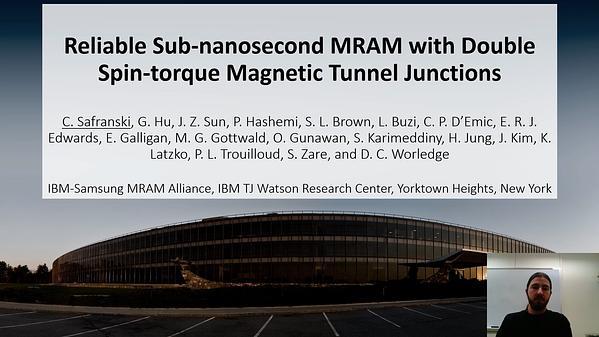Would you like to see your presentation here, made available to a global audience of researchers?
Add your own presentation or have us affordably record your next conference.
Experimental and computational studies on the stress-dependent magnetic property of silicon steel are on-going. A physical magnetization model, an energy-based
multiscale magnetization model called multi-domain particle model (MDPM) 1, was developed, which successfully predicted the stress-dependent properties of silicon steel without using
measured stress-dependent data.
To avoid measurement under arbitrary combination of stress and magnetization directions, several stress models have been developed. This study examines two of them by comparing with
the MDPM. One is the equivalent stress (ES) theory 2 and the other is the stress decomposition (SD) method 3. The latter assumes that the stress effect can be decomposed into its
principal directions.
A rotational single sheet tester applied a compressive stress to a non-oriented silicon steel sheet in the rolling direction (RD, φ=0). A magnetic field was applied along φ = 0 or π/4. Fig. 1
shows the measured stress dependence of hysteresis loss wx
in the RD when the amplitude of Bx
is 0.5, 0.7 and 1.0 T, where By has only a small effect on the stress dependence of wx
. It
supports the assumption of stress decomposition.
BH loops under the excitation angle of π/4 were simulated using the MDPM, where the directions of stress and applied magnetic field are denoted by φσ
and φH. Fig. 2 shows BH loops as
below: reference, blue lines φH=π/4 and φσ=0 with σ = −40, −80 MPa, ES theory, green lines φH=φσ=π/4 with σ = −10, −20 MPa based on the ES theory, SD, brown lines synthesized
loops of φH=φσ=0 with σ = −40, −80 MPa and φH=φσ=π/2 with σ = 0, and modified SD, red lines synthesized loops of φH=φσ=0 with σ = −40, −80 MPa and φH=φσ=π/2 with σ = +40,
+80 MPa. The ES theory roughly predicts the stress dependent loops along φ = π/4, but fails to predict decomposed loops along φ = 0, π/2. The SD fails to reconstruct loops along φ=π/2
because a compressive stress along φ=0 acts as a tensile stress along φ=π/2. The modified SD roughly predicts the stress dependent loops in all the directions by giving tensile stresses
along φ=π/2.
References
1 T. Matsuo, Y. Takahashi, K. Fujiwara, J. Magn. Magn. Mater., vol. 499, 166303, 2020.
2 M. Rekik, L. Daniel, O. Hubert, IEEE Trans. Magn., vol. 50, 2001604, 2014.
3 M. Nakano, et. al, IEEJ Trans. Ind. Appl., vol. 129, pp. 1060–1067, 2009.

Comparison of measured loss increase Δwx with φH = 0, π/4 and φσ = 0.

Simulated BH loops along (a) φ = π/4, (b) φ = 0, and (c) φ = π/2.
